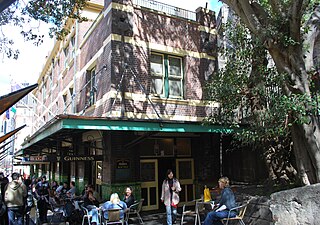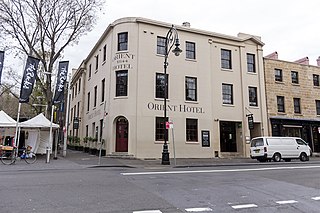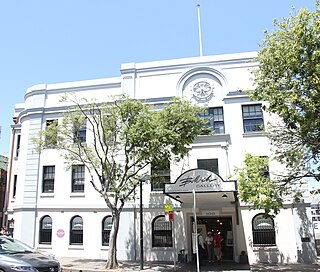
The Brooklyn Hotel is a heritage-listed bar, restaurant and former hotel located at 229 George Street, in the suburb of The Rocks, in the city of Sydney, New South Wales, Australia. It was designed by Walter Liberty Vernon and built in 1912. The property is owned by Property NSW, an agency of the Government of New South Wales. It was added to the New South Wales State Heritage Register on 10 May 2002.

The Mercantile Hotel is a heritage-listed pub located at 25–27 George Street, in the inner city Sydney suburb of The Rocks in the City of Sydney local government area of New South Wales, Australia. It was designed by Spain & Cosh Architects and built in 1914. The property is owned by Place Management NSW, an agency of the Government of New South Wales. It was added to the New South Wales State Heritage Register on 10 May 2002.

The Orient Hotel is a heritage-listed pub located at 87–89 George Street, in the inner city Sydney suburb of The Rocks in the City of Sydney local government area of New South Wales, Australia. It was built from 1843 to 1844. The property is owned by Property NSW, an agency of the Government of New South Wales. It was added to the New South Wales State Heritage Register on 10 May 2002.

The Lord Nelson Hotel is a heritage-listed pub and hotel located at 19 Kent Street, Millers Point, Sydney, New South Wales, Australia. It was built by James Dempsey around 1814 to 1815. James Dempsey was originally a stonemason born in Ireland. It is the oldest working licensed hotel in Sydney. It was added to the New South Wales State Heritage Register on 2 April 1999.

The Argyle Stores is a heritage-listed former custom house and bond store that now serves as offices, bar, function rooms and restaurant located at 12–20 Argyle Street in the inner-city Sydney suburb of The Rocks in the City of Sydney local government area of New South Wales, Australia. Henry Cooper designed the east wing, and the designer of all other wings is not known. The Argyle Stores were built from 1826 to 1878, and is also known as Argyle Bond Stores and Cleland Bond Store. The property is owned by Property NSW, an agency of the Government of New South Wales. It was added to the New South Wales State Heritage Register on 10 May 2002.

The Argyle Terrace – Caminetto's Restaurant is a heritage-listed former residence and now restaurant located at 13–15 Playfair Street in the inner city Sydney suburb of The Rocks in the City of Sydney local government area of New South Wales, Australia. It was designed by built for Thomas Playfair from 1883 to 1884. It is also known as Former Harry's Bar and Sorrentos. The property is owned by Property NSW, an agency of the Government of New South Wales. It was added to the New South Wales State Heritage Register on 10 May 2002.

Reynolds's Cottages is a heritage-listed former retail building and residence and now retail building and cafe at 28–30 Harrington Street, The Rocks, City of Sydney, New South Wales, Australia. It was built for Thomas Ryan in 1830. It is also known as Gumnut Cafe. The property is owned by Property NSW, an agency of the Government of New South Wales. It was added to the New South Wales State Heritage Register on 10 May 2002.

The Raphael Mackeller Stores is a heritage-listed former store and now museum located at 4–6 Kendall Lane in the inner city Sydney suburb of The Rocks in the City of Sydney local government area of New South Wales, Australia. It was built from 1853 to 1854 for Joseph George Raphael. It is also known as The Rocks Toy Museum, Unwin's Coach House, Coach House, and The Coachhouse. The property is owned by Property NSW, an agency of the Government of New South Wales. It was added to the New South Wales State Heritage Register on 10 May 2002.

Samson's Cottage wall remains is a heritage-listed former residence and now retail building located at 8 Kendall Lane, in the inner city Sydney suburb of The Rocks in the City of Sydney local government area of New South Wales, Australia. It was built for William Samson in 1844. It is also known as Samson's Cottage (wall remains) and Puppet Cottage (Samsons). The property is owned by Property NSW, an agency of the Government of New South Wales. It was added to the New South Wales State Heritage Register on 10 May 2002.

Samson's Cottage is a historic building in Sydney, Australia. It was built for William Cormack and built from 1883, and over the years, it has housed a Chinese laundry, an art gallery and an antique shop. It is located at 75–75.5 George Street in the inner city suburb of The Rocks in the City of Sydney local government area. The property is owned by Property NSW, an agency of the Government of New South Wales. It was added to the New South Wales State Heritage Register on 10 May 2002.

The Unwin's Stores are heritage-listed shops and formerly a residence located at 77–85 George Street in the inner city Sydney suburb of The Rocks in the City of Sydney local government area of New South Wales, Australia. It was built from 1843 to 1846 for Frederick Wright Unwin. It is also known as Unwins. The property is owned by Property NSW, an agency of the Government of New South Wales. It was added to the New South Wales State Heritage Register on 10 May 2002.

93 George Street, The Rocks is a heritage-listed former dwelling and now retail building located at 93 George Street in the inner city Sydney suburb of The Rocks in the City of Sydney local government area of New South Wales, Australia. It was built in 1891. It is also known as Zia Pina Pizzeria. The property is owned by Property NSW, an agency of the Government of New South Wales. It was added to the New South Wales State Heritage Register on 10 May 2002.

The Old Police Station, The Rocks is a heritage-listed former police station and now home to Sergeant Lok, a Modern Asian restaurant and bar, that is located at 127–129 George Street in the inner city Sydney suburb of The Rocks in the City of Sydney local government area of New South Wales, Australia. It was designed by James Barnet and built in 1882 by W. Cains and Sons. The property is owned by Property NSW, an agency of the Government of New South Wales. It was added to the New South Wales State Heritage Register on 10 May 2002.

95-99 George Street, The Rocks are heritage-listed shops and cafe and former dwellings located at 95-99 George Street in the inner city Sydney suburb of The Rocks in the City of Sydney local government area of New South Wales, Australia. It was built from 1868 to 1868. The property is owned by Property NSW, an agency of the Government of New South Wales. It was added to the New South Wales State Heritage Register on 10 May 2002.

182 Cumberland Street, The Rocks is a heritage-listed retail building and residence located at 182 Cumberland Street, in the inner city Sydney suburb of The Rocks in the City of Sydney local government area of New South Wales, Australia. It was designed by Walter Liberty Vernon with the assistance of E. L. Drew and built from 1911 to 1912. The property is owned by Property NSW, an agency of the Government of New South Wales. It was added to the New South Wales State Heritage Register on 10 May 2002.

107–109 George Street, The Rocks is a heritage-listed restaurant and former retail building, residence and bakery located at 107–109 George Street, in the inner city suburb of The Rocks in the City of Sydney local government area of New South Wales, Australia. It was built during 1860. It is also known as Rockpool Restaurant (former); and William Blue Dining. The property is owned by Property NSW, an agency of the Government of New South Wales. It was added to the New South Wales State Heritage Register on 10 May 2002.

147 George Street, The Rocks is a heritage-listed former retail building and residence and now duty-free store complex located at 147 George Street, in the inner city Sydney suburb of The Rocks in the City of Sydney local government area of New South Wales, Australia. It was built during 1914. It is also known as part of a Duty Free Store complex. The property is owned by Property NSW, an agency of the Government of New South Wales. It was added to the New South Wales State Heritage Register on 10 May 2002.

149–151 George Street, The Rocks is a heritage-listed duty-free store complex and former retail building and residence located at 149–151 George Street, in the inner city Sydney suburb of The Rocks in the City of Sydney local government area of New South Wales, Australia. It was built from 1913 to 1913. It is also known as part of the Duty Free Store complex. The property is owned by Property NSW, an agency of the Government of New South Wales. It was added to the New South Wales State Heritage Register on 10 May 2002.

105 George Street, The Rocks is a heritage-listed shop and former residence located at 105 George Street, in the inner city Sydney suburb of The Rocks in the City of Sydney local government area of New South Wales, Australia. It was built during 1851 by persons unknown and redeveloped in 1985 by the Sydney Cove Redevelopment Authority with Co-Wyn Construction. It is also known as Kathmandu (current) and Beach Culture and Dorian Scott (former). Property NSW, an agency of the Government of New South Wales. It was added to the New South Wales State Heritage Register on 10 May 2002.

The Sydney Sailors' Home is a heritage-listed former sailors' home, theatre and visitor's centre and now gallery and restaurant, located at 106–108 George Street, in the inner city Sydney suburb of The Rocks in the City of Sydney local government area of New South Wales, Australia. It was designed and built in two stages: in 1864 by Weaver & Kemp and in 1926 by Spain and Cosh. It is also known as the former Marionette Theatre and The Rocks Heritage and Information Centre. The property is owned by Property NSW, an agency of the Government of New South Wales. It was added to the New South Wales State Heritage Register on 10 May 2002.






















